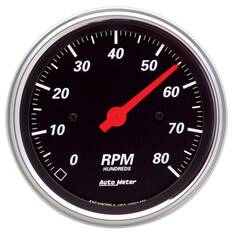Exactly how to Pick the Right Tachometer for Your Auto or Motorcycle
Exactly how to Pick the Right Tachometer for Your Auto or Motorcycle
Blog Article
The Relevance of a Tachometer in Checking Engine Rate and Efficiency in Automotive Applications
In the realm of auto design, the tachometer stands as a critical tool in the chauffeur's collection, giving a direct window into the inner operations of a vehicle's engine. Beyond its function as a plain scale of revolutions per minute (RPM), the tachometer offers as an important device for enthusiasts and specialists alike, supplying real-time understandings into engine efficiency and wellness.
Significance of Checking Engine RPM
Keeping an eye on engine RPM, or changes per minute, is a crucial facet of automotive upkeep and efficiency examination. Engine RPM directly associates with the rate at which the engine's crankshaft turns, suggesting exactly how promptly the engine is running - tachometer. By checking RPM, technicians can evaluate the health of the engine, discover possible problems, and fine-tune efficiency. An unusual RPM reading may signify troubles such as engine misfires, defective ignition system, or concerns with the fuel delivery system. Constantly high RPM analyses could indicate hostile driving routines or the requirement for a higher gear change to boost gas efficiency.
Furthermore, keeping an eye on engine RPM is crucial for efficiency examination in auto racing and high-performance cars. In recap, keeping track of engine RPM is not only essential for identifying problems however additionally for enhancing engine performance in different vehicle applications.

Benefits of Real-Time Data
In auto applications, real-time data plays a vital duty in providing immediate understandings right into the efficiency and condition of the lorry. By continuously monitoring different parameters such as engine rate, temperature, fuel usage, and extra, real-time information offers various benefits that add to enhanced performance and safety and security when driving.
One significant benefit of real-time information is its ability to alert motorists and technicians to any type of abnormalities or concerns without delay. This positive strategy allows quick recognition of prospective problems, permitting prompt interventions to avoid more damages or failures. In addition, real-time information helps with performance optimization by giving instant comments on driving practices and engine efficiency. Vehicle drivers can change their behavior in real-time based upon this information to accomplish better gas economy and extend the life-span of their vehicle.

In addition, real-time data plays a crucial function in modern-day auto diagnostics, enabling specialists to swiftly diagnose and attend to malfunctions. This results in decreased downtime, lower upkeep prices, and ultimately, enhanced overall lorry reliability and durability (tachometer). By utilizing the power of real-time information, auto stakeholders can make enlightened decisions that positively impact both the performance and long life of the car
Influence On Equipment Shifts
Efficient gear shifts in auto applications significantly influence general efficiency and driving experience. The tachometer plays an essential duty in optimizing gear shifts by providing real-time engine rate information to the driver. When approaching the redline on the tachometer, it indicates the chauffeur why not try this out to upshift to avoid over-revving the engine and causing potential damages. On the other hand, downshifting at the right minute can aid maintain the engine in its power band, guaranteeing responsive acceleration when needed.
Furthermore, the tachometer aids in achieving smoother equipment transitions, particularly in hands-on transmissions. By keeping track of engine rate, vehicle drivers can perform gear shifts at the optimal RPM array, decreasing jerking motions and decreasing wear on the transmission components. This accuracy in equipment adjustments not just boosts driving comfort but likewise contributes to fuel efficiency.
Enhancing Gas Performance
Offered the vital duty the tachometer plays in enhancing equipment shifts for performance and engine health, it directly adds to optimizing gas efficiency in automotive applications. By supplying real-time feedback on engine speed, the tachometer aids chauffeurs in keeping the most effective RPM array for gas economic situation. When view it now vehicle drivers consistently check the tachometer and readjust their motoring routines as necessary, they can avoid unneeded fuel usage triggered by over-revving or hauling the engine.
Moreover, the tachometer aids vehicle drivers identify the most fuel-efficient gear to be in at any kind of provided minute, stopping the engine from working more challenging than essential. This is especially important throughout acceleration and cruising, where being in the appropriate equipment can significantly impact fuel efficiency. Additionally, the tachometer can signal vehicle drivers to potential mechanical problems that can be adversely influencing gas economic climate, such as a sliding clutch or a clogged up air filter. Finally, the tachometer serves as a valuable tool in improving gas efficiency by promoting optimal driving behaviors and recognizing areas for improvement in the car's performance.

Taking Full Advantage Of Engine Durability
The tachometer's function in monitoring engine speed and efficiency is instrumental in making sure the durability of auto engines. Checking the tachometer permits drivers to remain within the recommended RPM range for their lorry, avoiding unnecessary stress on the engine and expanding its life expectancy.

Conclusion
In verdict, the tachometer plays an essential role in keeping track of linked here engine speed and performance in auto applications. By giving real-time data on RPM, it permits effective gear shifts, improved fuel effectiveness, and taken full advantage of engine longevity. This tool is vital for keeping ideal engine efficiency and guaranteeing the total functionality of an automobile.
Report this page